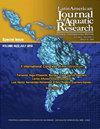Influence of temperature on respiratory metabolism during early development of Totoaba macdonaldi
IF 0.8
4区 农林科学
Q3 FISHERIES
Latin American Journal of Aquatic Research
Pub Date : 2023-02-28
DOI:10.3856/vol51-issue1-fulltext-2952
引用次数: 0
Abstract
Environmental temperature can act as a positive or negative modulator of the physiology and metabolism of poikilothermic organisms. As a general rule, larvae and juveniles are more sensitive to temperature stress than adults, which represents a key factor that partly determines their development and growth in aquaculture. Therefore, this study analyzed the effect of exposure to temperatures of 21, 24, and 27°C on the respiratory metabolism (RM) of Totoaba macdonaldi in different developmental stages. For this purpose, eggs, larvae with 4, 6, 8, 14, and 22 days post-hatch (dph), and juveniles of 25 dph were exposed to the experimental temperatures for 5 h. After the exposure time, oxygen consumption measurements were performed. The results clearly show that temperature (21 to 27°C) has the greatest effect on RM in eggs and larvae at 4 and 22 dph (3.1 ± 0.3 to 4.3 ± 0.3 μmol O2 h-1 egg-1, 2.9 ± 0.3 to 10.5 ± 1.2 μmol O2 h-1 larvae-1 and 102.0 ± 6.4 to 189.8 ± 15.3 μmol O2 h-1 larvae-1, respectively). This thermal sensitivity was not observed from 6, 8, and 14 dph larvae and juveniles at 25 dph, where morphological development was the main factor that influencing the RM. Therefore, this study shows that temperature affects RM in different development stages of totoaba, beginning in the egg stage and intensifying once the larvae hatch until 22 dph. Understanding how temperature affects energy expenditure by measuring RM is essential to establish culture conditions that allow better physiological performance and growth in the early life stages of T. macdonaldi.温度对麦当劳石首鱼发育早期呼吸代谢的影响
环境温度对变热生物的生理和代谢具有积极或消极的调节作用。一般来说,幼虫和幼鱼对温度胁迫比成鱼更敏感,这在一定程度上决定了它们在水产养殖中的发育和生长。因此,本研究分析了21℃、24℃和27℃温度对麦克唐纳湾石斑鱼不同发育阶段呼吸代谢(RM)的影响。为此,将卵、孵化后4、6、8、14和22天的幼虫以及孵化后25天的幼鱼暴露在实验温度下5小时。暴露时间结束后,进行耗氧量测量。结果表明,温度(21 ~ 27℃)对4和22 dph下卵和幼虫RM的影响最大(分别为3.1±0.3 ~ 4.3±0.3 μmol O2 h-1卵-1、2.9±0.3 ~ 10.5±1.2 μmol O2 h-1幼虫-1和102.0±6.4 ~ 189.8±15.3 μmol O2 h-1幼虫-1)。在6、8和14 dph的幼虫和25 dph的幼鱼中没有观察到这种热敏性,其中形态发育是影响RM的主要因素。因此,本研究表明,温度对石首鱼不同发育阶段的RM有影响,从卵期开始,在幼虫孵化至22 dph后逐渐增强。通过测量RM来了解温度如何影响能量消耗,对于建立培养条件,从而在T. macdonaldi生命早期获得更好的生理性能和生长至关重要。
本文章由计算机程序翻译,如有差异,请以英文原文为准。
求助全文
约1分钟内获得全文
求助全文
来源期刊

Latin American Journal of Aquatic Research
FISHERIES-MARINE & FRESHWATER BIOLOGY
CiteScore
1.70
自引率
10.00%
发文量
44
审稿时长
4-8 weeks
期刊介绍:
Latin American Journal of Aquatic Research- LAJAR is the continuation of the journal Investigaciones Marinas (1970-2007) and is published since 2008 by the Escuela de Ciencias del Mar, Facultad de Ciencias del Mar y Geografía of the Pontificia Universidad Católica de Valparaíso. LAJAR is an “Open Access” journal that publishes in English language, original research articles, reviews and short communications on aquatic science, which contain the results of research conducted in aquaculture or in oceanic and coastal marine waters of Latin America.
The following topics are considered: Physical Oceanography, Chemical Oceanography, Marine Biogeochemistry, Marine Pollution and Toxicology, Marine Geology and Geophysics, Biological Oceanography, Fisheries and Aquaculture.
 求助内容:
求助内容: 应助结果提醒方式:
应助结果提醒方式:


